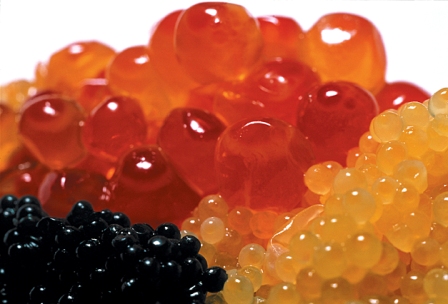brief, 3 main russian types, possible pairing, recipe

Russian Caviar comes from the sturgeon, a bony and spineless fish that dates back to the time of the dinosaurs. It must be the most delicious of all the dishes traditionally presented on the Russian zakuska tables (hors d’oevres tables). It certainly is the most valuable fish in Russia today. The first time Russian caviar was presented to the world was in 1900 at the great World Exhibition in Paris.
In the Soviet times it was a “poor mans food”, eaten by Black Sea fisherman for breakfast, given to the soldiers and sold, in huge quantities, in ordinary food stores during the 1960’s! Nowadays it is expensive, rare and too often illegally caught and distributed, leading to overfishing and indiscriminate poaching.

Malossol is a slightly salted caviar that keeps for up to a year. (The saltier caviar is often the inferior quality)
Beluga (image above) the true caviar, an exclusive rarity that comes from the biggest of the sturgeon is the most expensive caviar on the market today. The large, thin skinned, silver grey grains have a loose texture and a taste too exquisite to put into words. Not for nothing has this become the best in the world. This sturgeon is caught in the Caspian and the Black sea as well as the Dnieper and the Dniester rivers.
Osyotr caviar, also from the sturgeon has a nutty taste. The colours range from bluish black to dark green and then to silver. Royal black caviar is an Osyotr speciality and comes from the young fish and has a dark black and has a thin shell. Though delicious, as far as I am concerned, it doesn’t beat the Beluga.

Sevruga is the smallest grained caviar and has a slightly harder shell with a tangy taste. The individual grain is small, the size of a pin head, and the colour ranges from mid to darkish grey. This sturgeon hails from the Black, the Caspian and the Aral seas as well as the Don, the Kuban rivers and the Syr and Amu Dayra’s (in Kazakhstan)
False Caviar (red Salmon caviar) comes from the chum salmon of the East Pacific as well as the Amur or the King salmon.
Pink Caviar from the whitefish, muksun or sea trout is a Siberian delicacy and they are welcome to it.
The yellowish orange, course grained caviar from the Lake Baikal salmon has a delicate flavour.
Roe of a variety of fish (hake, cod, pike and zander) is pressed and the so called German caviar is dyed red or black and used for decorative purposes.
Red Salmon Yellow Lemon Pasta
500 g Spaghetti
1 finely chopped shallot (optional)
lemon zest from one lemon plus juice from half a lemon
375 ml pouring cream
250 ml sour cream
salt and pepper to taste
handful chopped fresh dill (or parsley)
2 containers red salmon caviar (under no circumstances buy the ‘German’ caviar! The dye colours the whole dish and it looks disgusting)
Method
Boil the water in abundant salted water until ready, reserving some of the cooking liquid. Melt butter in a pan, add the cream and heat until it just reaches boiling point. Remove from the heat and add the lemon zest, half the dill or parsley (reserving the rest for the sour cream), caviar, salt and pepper. As soon as the pasta is ready, toss into the cream mixture and combine well, adding the lemon juice bit by bit. Under no circumstances heat or cook the caviar! Check the taste and correct. Put the pasta into the serving dish, combine dill and chopped shallot with sour cream to serve on the side. Serve immediately with salad.
There are people, like my son Richardt who would eat it with good freshly grated Parmesan, but since it is sea food, I prefer not to.
Have it with a chilled Crimean sparkling wine like a Yubileynoye (that means rose) from the Novy Svet wine cellars – or if you live anywhere else, why not support your local cellars, if they are any good?
How do you know that the caviar is fresh?
The grains should fall apart (unless it’s pressed caviar) immediately. No colour must come off, they must be very shiny, never dull and without an invasive smell or taste of fish that would mask the nuttiness of the caviar.
Always serve in a glass bowl, on crushed ice and always eat this delicacy cold.
The best thing to drink with caviar is a good Crimean ‘champagne’ or vodka.
Russians like to serve it with golden yellow blini and little bowls of capers, chopped onions, parsley, chopped hardboiled eggs, and loads of sour cream for the blini.




You have posted absolutely exclusive photos. Wow! It was a pleasure to see them.
It somehow reminds me of Caviar Black Pearl. I’m sure you know what I’m talking about – the premium caviar taste.
Absolutely luxurious photos. Thanks for sharing!
Hi! Just love to eat 🙂 – for that kind comment, another quick snippet on Caviar today.